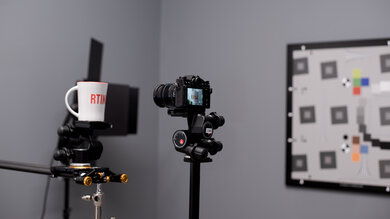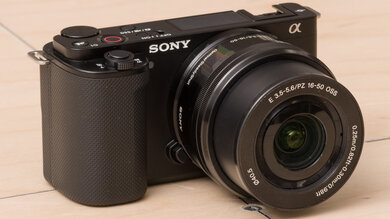
As is often the case, the best camera for the job is usually the one you've already got on you, and that's especially true when you're traveling and likely don't have the space to pack a bulky camera kit. A smartphone will suffice for most people, especially since smartphone cameras are getting more impressive by the year. But if you want to take your travel photography to the next level, a mirrorless interchangeable lens camera will get you there. While the battery life on mirrorless cameras isn't as strong as their DSLR counterparts, they're tough to beat on portability, making them great travel cameras if you also want the flexibility to shoot with different lenses.
We've bought and tested over 100 cameras in our lab, and below, you'll find our recommendations for the best mirrorless cameras for travel. In this article, we limit ourselves to mirrorless cameras with interchangeable lenses. If you'd prefer a fixed-lens compact camera, check out our best compact cameras for travel instead. You can also check out our top vlogging cameras if you're a travel vlogger. Or, if you want a mirrorless camera for use beyond just traveling, see our recommendations for the best mirrorless cameras overall.
-
Best Mirrorless Camera For Travel
Travel PhotographyLandscape PhotographySport & Wildlife PhotographyRaw Photo PerformanceVloggingStudio VideoAction VideoAmong mirrorless options, the Fujifilm X-T5 stands out as one of the best for travel photography. It's aimed at enthusiast photographers, and it has old-school exposure dials that make it easy to adjust settings on the go. It also has a relatively portable, lightweight design and sturdy build, with weather-sealing for added peace of mind when shooting in poor weather conditions. Beyond its sleek exterior, it also comes equipped with one of the highest-resolution APS-C sensors on the market, with a whopping 40.2 megapixels, so it captures incredibly detailed images with plenty of leeway to crop and adjust your photos.
If that wasn't enough, it has an excellent battery life for a mirrorless model and features Fujifilm's most advanced autofocus yet, with intuitive AF tracking and subject detection for a wide range of subjects, including people, birds, and vehicles. Plus, the wide range of excellent, portable lenses available for Fuji's X mount is another bonus. Overall, the X-T5's combination of image quality, portability, and photography-first design make it our top pick for the intrepid travel photographer.
-
Best Full Frame Mirrorless Camera For Travel
Travel PhotographyLandscape PhotographySport & Wildlife PhotographyRaw Photo PerformanceVloggingStudio VideoAction VideoIf you're looking for the best possible image quality, the Sony α7C II is hard to beat for high-level, National Geographic-worthy travel photography. It's one of the most compact full-frame bodies on the market, and while full-frame lenses are still bigger than APS-C or Micro Four Thirds alternatives, the compact body helps make a more portable kit. Its compact size does mean fewer custom buttons and an uncomfortably small viewfinder; however, these are small sacrifices to make if you need portability but still want the greater dynamic range and noise handling that comes with a full-frame sensor.
Though the camera's 33-megapixel sensor is its real selling point, it also boasts a long battery life, excellent weather-sealed build quality, and one of the best autofocus systems on the market, not to mention a wide range of both native and third-party lens options. If you want to save some money, you can find the original Sony α7C for a steal, considering how similarly it performs for photography, though it has a slightly lower-resolution sensor and uses an older version of Sony's AF.
-
Best Upper Mid-Range Mirrorless Camera For Travel
Travel PhotographyLandscape PhotographySport & Wildlife PhotographyRaw Photo PerformanceVloggingStudio VideoAction VideoMicro Four Thirds (MFT) models like the OM SYSTEM OM-5 are practically made for travel photography. Though there's a slight trade-off in low-light noise handling with an MFT sensor, the camera can still capture beautiful images, especially when paired with a good lens. Beyond that, it's packed with some neat computational features, like a digital ND filter and a high-resolution composite mode to capture stunningly detailed landscapes. Plus, the MFT system has a well-established lineup of lenses, including more compact options that'll make for a more portable overall kit.
On top of that, the OM-5 is weather-sealed and ruggedly built, giving you some peace of mind while traveling. Built-in image stabilization allows you to get clear shots at slower shutter speeds, and the camera has a decent autofocus system, though it falls short of the standard set by brands like Sony and Canon. Battery life is also underwhelming, but this model is still a sure bet if you're looking for a portable and feature-rich camera system at a reasonable price point. If you can find it for cheaper, the older Olympus OM-D E-M5 Mark III offers near-identical performance, though it uses an older sensor and lacks a few extra features found on the OM-5, like 'Live ND.'
-
Best Mid-Range Mirrorless Camera For Travel
Travel PhotographyLandscape PhotographySport & Wildlife PhotographyRaw Photo PerformanceVloggingStudio VideoAction VideoAs far as mid-range options go, the Fujifilm X-T30 II is an excellent choice with a highly portable body. Like the higher-end Fujifilm X-T5 above, it has a sleek retro-inspired design with the same exposure dial setup, giving you more hands-on control over camera settings on the fly. The camera's APS-C sensor also captures excellent image quality, with film simulation profiles that let you change up the look of your photos in-camera.
While competitors like the Sony α6400 (or one of its α6x00 series siblings) might have better autofocus, the combination of physical controls and Fujifilm's excellent in-camera processing make this camera a blast to shoot with. Throw in a solid selection of fast prime lenses, and you've got a great camera for travel photography, particularly if you're interested in capturing people or street scenes. That said, unlike the OM SYSTEM OM-5 mentioned above, there's no IBIS here, and the camera is less versatile for videos and vlogs because of its tilt screen.
-
Best Budget Mirrorless Camera For Travel
Travel PhotographyLandscape PhotographySport & Wildlife PhotographyRaw Photo PerformanceVloggingStudio VideoAction VideoIf you're on a tighter budget, the small and mighty Olympus OM-D E-M10 Mark IV offers a ton of value for its price. Like its higher-end sibling above, it uses an MFT sensor, making for a more portable overall kit with a budget-friendly price tag. It's a great option for beginners, with simple controls and plenty of creative shooting modes that allow you to play with different photography styles.
Beyond that, this is one of the few cameras at this price point with in-body image stabilization, which can help reduce camera shake in videos or make it easier to get clear handheld shots at slower shutter speeds. That said, this model doesn't have the most reliable autofocus, so if that's important to you, the Canon EOS R50 is a good alternative with a larger APS-C sensor and a more effective AF system. Just be aware that there are fewer lens options for Canon's RF mount, and the lenses are generally bigger.
-
Best Mirrorless Vlogging Camera For Travel
Travel PhotographyLandscape PhotographySport & Wildlife PhotographyRaw Photo PerformanceVloggingStudio VideoAction VideoIf you're more inclined to shoot videos while traveling, consider a vlogging camera like the Sony ZV-E10. It's small and lightweight, so it's easy to toss into a bag and take on the go. While it doesn't have a viewfinder like the Olympus OM-D E-M10 Mark IV, its fully articulated screen is perfect for vlogging, allowing you to monitor yourself while shooting. It also has vlogging-friendly features like a detachable windscreen to reduce ambient noise, specialized focus modes, and a great battery life.
It's worth noting that the camera doesn't have built-in stabilization, and its e-stabilization feature can introduce a distracting wobble effect, so you're better off using an optically stabilized lens if you want to keep the camera shake to a minimum. Otherwise, the ZV-E10's relatively low price, convenient size, and great video quality make this the ideal mirrorless camera for travel vlogging.
Notable Mentions
- Fujifilm X-T4: The Fujifilm X-T4 is the predecessor to the Fujifilm X-T5, and though it's a tad heavier, it's a great choice if you want to save money, offering many of the same advantages. It uses an older processor, a lower-resolution sensor, and a less reliable autofocus system. See our review
- OM SYSTEM OM-1: The OM SYSTEM OM-1 is a fantastic Micro Four Thirds camera. It's more rugged and better built than the OM SYSTEM OM-5, but it's also pricier and likely overkill for most people. See our review
Recent Updates
-
May 16, 2024: We replaced the Sony α7C with the Sony α7C II because it has better availability than its predecessor, but we still recommend the original α7C as a cheaper alternative.
-
Mar 20, 2024: We've reviewed the article to ensure the picks and text are up to date.
-
Jan 26, 2024: Replaced the Olympus OM-D E-M5 Mark III with the OM SYSTEM OM-5, as it's more widely available.
-
Oct 27, 2023: Added mention of the Sony α7C II to flesh out the market context for the Sony a7C.
-
Aug 31, 2023: Added the Fujifilm X-T5 as the 'Best Mirrorless Camera For Travel' and shifted the Olympus OM-D E-M5 Mark III down to the upper mid-range spot.
All Reviews
Our recommendations above are what we think are currently the best mirrorless cameras for travel for most people to buy, according to their needs. We factor in the price, feedback from our visitors, and availability (no cameras that are difficult to find or almost out of stock in the U.S.).
If you'd like to choose for yourself, here's the list of all our interchangeable-lens mirrorless camera reviews, ranked by their suitability for travel photography. Be careful not to get caught up in the details. There is no single perfect camera. Personal taste, preference, and shooting habits will matter more in your selection.





























